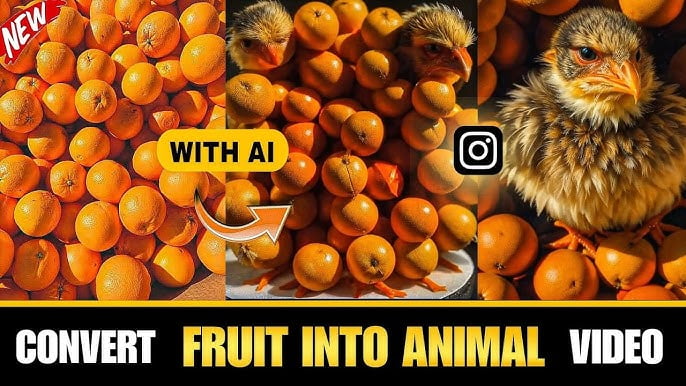In the Transforming Fruit into Animals realm of digital creativity, the fusion of seemingly unrelated elements can yield mesmerizing and imaginative results. One of the most intriguing and visually striking concepts is transforming fruit into animals in a video. This whimsical idea not only captures the imagination but also offers endless possibilities for creative expression. Whether you’re a budding content creator or simply looking for a fun project, this guide will walk you through the process of making a fruit-turning-into-an-animal video, from initial concept to final edit.
Conceptualizing Your Video
1. Choosing Your Fruit and Animal
The first step in creating a fruit-to-animal transformation video is to decide on the specific fruit and animal you want to feature. Consider the following factors:
- Fruit Selection: Choose a fruit with a distinctive shape and texture that can easily be associated with an animal. For instance, a pineapple could transform into a porcupine due to its spiky texture, while a watermelon might become a turtle with its rounded shape.
- Animal Choice: Select an animal that complements the fruit’s characteristics. Think about how the fruit’s shape and color can be creatively incorporated into the animal’s features.
2. Sketching Your Concept
Before diving into filming, sketch out your concept to visualize how the fruit will transition into the animal. This sketch doesn’t need to be highly detailed but should give you a rough idea of the transformation process. Consider the following elements:
- Transformation Sequence: Plan out how the fruit will morph into the animal. This could involve gradual changes, such as the fruit growing limbs or sprouting fur, or more abrupt transitions.
- Scene Setup: Decide on the background, lighting, and any props you’ll need to enhance the visual appeal of your video.
Filming the Transformation Fruit into Animals in 2024
1. Preparing Your Fruit and Props
Prepare your fruit and any props you’ll be using in advance. Here’s what you need to do:
- Fruit Preparation: Clean and cut the fruit as needed for your video. Ensure that it’s fresh and in good condition to avoid any unpleasant surprises during filming.
- Props and Materials: Gather any additional materials, such as fake animal fur, feathers, or paint, that you’ll use to create the animal’s features.
2. Setting Up Your Filming Space
Create a suitable filming environment by setting up your space with the following considerations:
- Background: Choose a background that complements your concept. This could be a simple color backdrop or a themed set that matches the animal you’re creating.
- Lighting: Ensure that your filming area is well-lit to capture clear and vibrant footage. Use natural light or studio lights to achieve the desired effect.
- Camera Setup: Position your camera or smartphone on a stable surface or tripod to ensure steady shots. Consider using a high-resolution setting for better quality.
3. Filming the Transformation
When you’re ready to start filming, follow these steps to capture the transformation process:
- Initial Footage: Begin by filming the fruit in its original state. Capture different angles and close-ups to provide a solid base for your video.
- Transformation Sequence: Record the transformation process, whether it involves physically altering the fruit or using special effects. Ensure that the changes are smooth and coherent.
- Animal Reveal: Film the final stages of the transformation as the fruit becomes the animal. Use close-ups and different angles to highlight the completed transformation.
Editing Your Video
1. Importing and Organizing Footage
Once you’ve filmed all the necessary footage, import it into your video editing software. Organize your clips into a timeline and label them for easy access. This will help you keep track of the different stages of the transformation.
2. Creating the Transformation Effect
The transformation effect is the heart of your video, and it involves blending the fruit and animal footage seamlessly. Here’s how to achieve this:
- Cut and Trim Clips: Remove any unnecessary parts of your footage and trim the clips to focus on the key moments of the transformation.
- Use Transitions: Apply smooth transitions between the fruit and animal footage. Cross-dissolves, morphing effects, or custom transitions can create a seamless blend.
- Add Visual Effects: Enhance the transformation with visual effects such as particle animations, color adjustments, or blending modes. This can make the transition appear more magical and fluid.
3. Incorporating Sound and Music
Sound and music play a crucial role in enhancing the overall experience of your video. Consider the following:
- Sound Effects: Add sound effects that complement the transformation, such as fruit being cut or animal sounds. This adds an extra layer of realism and engagement.
- Background Music: Choose background music that matches the tone of your video. Whether it’s whimsical, dramatic, or upbeat, the music should enhance the visual elements without overpowering them.
- Audio Editing: Sync the sound effects and music with the video to create a cohesive audio-visual experience. Adjust the volume levels and apply fades as needed.
4. Adding Titles and Text
Include titles and text to provide context and enhance the narrative of your video. This could involve:
- Title Screen: Add a title screen at the beginning of the video to introduce the concept, such as “Fruit-to-Animal Transformation.”
- Text Overlays: Use text overlays to highlight key moments or provide additional information about the fruit and animal being featured.
- Credits: Include credits at the end of the video to acknowledge any collaborators or sources of inspiration.
5. Reviewing and Finalizing
Review your video thoroughly to ensure that the transformation effect is smooth, the audio is well-synced, and the overall quality meets your standards. Make any necessary adjustments and finalize your edit.
Sharing Your Video
1. Exporting Your Video
Export your video in the appropriate format and resolution for your intended platform. Common formats include MP4 and MOV, while resolutions can range from 1080p to 4K, depending on your needs.
2. Publishing and Promotion
Share your video on social media platforms, video-sharing sites, or your personal website. Use engaging descriptions and relevant hashtags to attract viewers and encourage sharing.
3. Engaging with Your Audience
Engage with your audience by responding to comments and feedback. Consider creating follow-up content or behind-the-scenes videos to keep your viewers interested and connected.
Creative Variations and Ideas
To keep your content fresh and exciting, consider experimenting with different variations of the fruit-to-animal transformation concept:
- Seasonal Themes: Incorporate seasonal fruits and animals to create themed videos, such as a pumpkin turning into a bat for Halloween.
- Multiple Fruits: Combine several fruits to create a more complex animal transformation or to showcase different stages of the transformation process.
- Interactive Elements: Create interactive videos where viewers can choose the fruit or animal for the transformation, adding an element of engagement and personalization.



